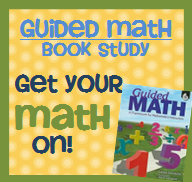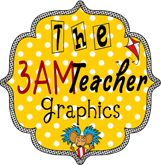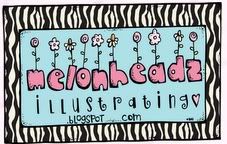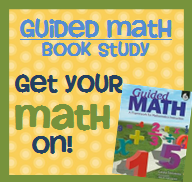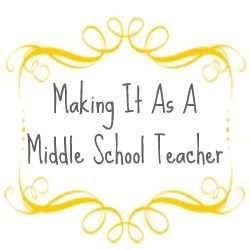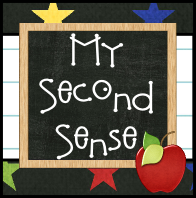 All I can say is I am LOVING this book. I've decided to do two separate posts on chapter 2. This way I don't overload you all. Today's will be focusing on the Review and Reflect questions at the end of the chapter. Tomorrow's (aka my bday) will be Jots and Thoughts. Jots and Thoughts will be a recap of my thoughts while reading certain oarts and what I jotted down on the margin.
All I can say is I am LOVING this book. I've decided to do two separate posts on chapter 2. This way I don't overload you all. Today's will be focusing on the Review and Reflect questions at the end of the chapter. Tomorrow's (aka my bday) will be Jots and Thoughts. Jots and Thoughts will be a recap of my thoughts while reading certain oarts and what I jotted down on the margin.
Without further ado, Review and Reflect Chapter 2. . .
1. Look back at the Foundational Principles of Guided Math (page 37). Which do you think are the two most important of these principles? Why? How does your classroom reflect those principles?
First off the Foundational Principles of Guided Math are:
- All students can learn mathematics
- A numeracy rich environment promotes mathematical learning by students
- learning at its best is a social process
- learning mathematics is a constructive process
- an organized classroom environment supports the learning process
- modeling and think-alouds, combined with ample opportunities for guided and then independent problem solving and purposeful conversations, create a learning environment in which students’ mathematical understanding grows
- Ultimately, students are responsible for their learning
Now before I tell you the two I choose to be the “most important” I want to say they all are (I know a cop out) but that is not to say that two do stand out to me as very important.
All students can learn mathematics
and
Ultimately, students are responsible for their learning
Choosing these two foundational principles may appear to some as, I, the teacher not taking responsibility for teaching. Quite on the contrary, saying that all students can learn mathematics to me means I MUST set HIGH expectations on my students. Students will meet your high expectations! As a student I met them when teachers set the expectations high and made it known to me. Those were some of the most rewarding learning experiences. As a teacher, it is important to encourage students in their learning, give them all the tools you can to help them meet the high expectations I set. And guess what? Setting high expectations implies ALL students can learn math.
Here’s another little secret I discovered this past year. . . When students realize the high expectations put on them in a NURTURING and LOVING classroom community environment they also realize they must contribute to that environment. In my classroom that means emphasizing the importance of them! It is their responsibility to learn. All I can do is give them the tools the best I possibly can. They must DO the learning. I know can you believe I have the nerve to say that ;) Gee some days I truly think the students and/or their parents think that they just need to show up and thats it. You want to know what else is sad about that? Some teachers let that occur. I pray that won’t be me. So the two most foundational principles in my classroom are
All students can learn mathematics
and
Ultimately, students are responsible for their learning
My classroom reflects the importance of these two principles in what I say. . .
“I need you to do the best you can do.” “Is this your best work?” “How could you do this better?” etc. . . Also, I believe it is important not to give my students the answers to work, i.e, they are responsible for their learning. I try and guide them to the answer or use the scaffolding technique (got to love that)!
I can’t wait to hear which ones you think are the two most important and WHY? You MUST tell me why! lol You know we always ask our students explain their answers so we should be doing the same . . . You know since we are suppose to be modeling and all :)
2. DO you think your students feel that they are members of a mathematical learning community? If so, how did you establish that feeling of community? If not, what can you do to create it?
I think that I will be focusing a lot on creating a mathematical community in my classroom this coming year. Truly the thought never crossed my mind. Creating a classroom environment where there is a pronounced “community” between the students and the teacher was all I had considered. That was evident in my classroom but as far as the math I can’t wait to make that happen next year. My mind is spinning with ideas. More on that in my Thoughts and Jots post tomorrow.
There was a math bulletin board last year in my room which had math station rules, math vocabulary, and some anchor charts. As good as that sounds it wasn’t updated enough. I think one of the things I will be doing on the FIRST day of school this coming year is creating a “Everyday Math” anchor chart with the students emphasizing the math we use everyday. I think it will be quite eye opening for the students. It will help them make math to self and math to world connections!
3. Look at your classroom through the eyes of a new student. Walking into your class, what would he or she see that would indicate the importance of mathematics?
At the moment they would see quite a bit of boxes and tarps . . . hehe ;) Couldn’t resist it. If a new student was walking in my classroom last year they would have seen the picture below showing an area of the room dedicated to math. There is also a calendar wall on the east front wall. I do have some rearranging planned in my head for this coming year but I like to have dedicated ares for anchor charts and subject specific things in the room.
 |
| The Math bulletin board is bordered in the yellow. I don't have a ton of wall space so things are what they are. I have a "math talk" speech bubble to showcase the math vocabulary words. The math workstation rules are also posted. |
 |
This is my math organization for "current" in use math materials. I LOVE this! It has worked out so well. It also takes a significant space that draws students attention to all the "math."
I would love to read which TWO Foundational Principals of Guided Math you would choose as most important! The only catch is you must explain why you chose those! I think it would be great to read each others thoughts on that! |








